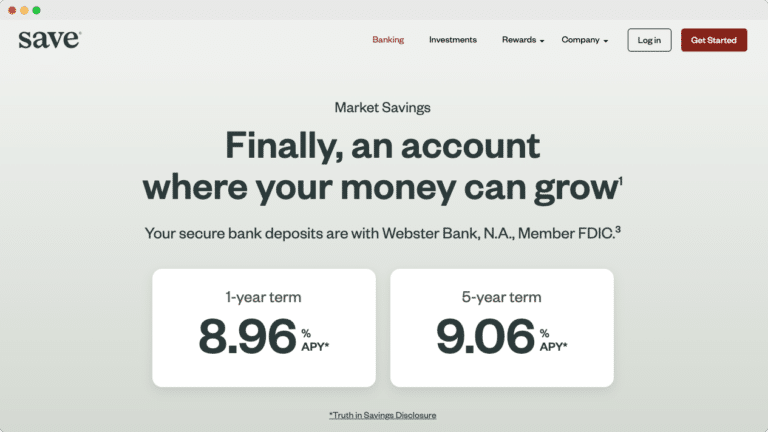Peer-to-Peer Lending: What is it? Best Websites for P2P Lending?
Peer-to-peer lending is an alternative to traditional institutional lending. It’s a way to borrow from individuals instead of from a traditional financial institution.
Peer-to-peer lending can also be a good way to invest your money and get a solid return. With traditional banks paying low interest on savings accounts and CDs, investing via a P2P platform can help you earn more.
Let’s go over some of the basics more in-depth so you can determine if peer-to-peer lending is a good fit for your finances.
What is Peer-to-Peer Lending?
In peer lending, or social lending as it’s sometimes called, the banks and credit card companies are bypassed and a middle-man company manages loans from people to other people. Money is lent, money is borrowed, money is paid back. Simple.
The idea is that the borrowing process will be more pleasant if banks are excluded. And money is more likely to be paid back if you know you are paying back individuals and not some faceless bank.
Before, when consumers needed a loan, they typically turned to banks and credit card companies, or other traditional institutions, to help fill the need. If they were rejected for a loan, they would turn to friends and family to help up out.
In those cases, they would either get a direct loan from them or get a co-signer for a traditional loan. Or, just do without the loan entirely.

Peer-to-peer lending, thanks to the power of the Internet, makes it easier to get loans from other people. It’s the sophisticated way of bypassing the banks.
Also, because so many people get involved, the risk to the lender can be greatly reduced, similar to how a mutual fund reduces the risk in the stock market.
Who Participates in Peer-to-Peer Lending?
You can get involved with peer to peer lending both as a borrower and a lender (investor). People borrow for all sorts of reasons (e.g. payoff debt, prop up their business, to pay for school, a wedding, or a vacation).
People lend (or invest) for one reason: to get a return on their money.
One of the advantages of P2P lending is that it’s mostly an online activity. From the application to the loan approval and payments, everything can be done from the comfort of your home.
How Does Peer-to-Peer Lending Work?
Borrowers are pre-screened by the lending service and given a credit limit and interest rate at which they can borrow money. They then have access to the funds and a payment schedule to pay back the loan.
As a lender, you decide how much money you want to invest, build a portfolio of loans (small amounts spread across many loans), and sit back and rake in the returns. There is some risk involved though, so be smart about how much money you invest here.
When investing through social lending sites, don’t lose sight of the fact that a lot of borrowers are there because they couldn’t get a loan elsewhere.
Keep in mind that not everyone can participate. Borrowers are screened for creditworthiness. And lenders are restricted by state rules so check to make sure you can participate.
Peer-to-Peer Loan Application Process
Each P2P lender has different rules for who qualifies for a loan. However, there are a few things they have in common when it comes to the loan application process.
- Initial Questionnaire: Most P2P platforms do a soft credit pull to check the borrower’s credit score. Lenders use this to assign you a loan grade. Before completing this step, you may want to check out Experian Boost to see how they can boost your score.
- Loan Grade: Based on their credit, the lender will assign a loan grade. This tells potential investors what risk they would take on if they were to invest money by funding a portion or all of the loan.
- Investor Interest: Since P2P lending relies on investors funding a loan, borrowers are not guaranteed the funds even after their application is approved. Enough investors need to show interest in funding the loan before it’s eligible.
- Documentation: Just like with a traditional lender, borrowers need to show proof of income and employment. Additionally, they’ll need to show a list of existing debts.
- Loan Approval: Once the loan is approved and fully funded, borrowers receive a loan document packet for their signature. Most peer-to-peer lenders will wire the money to their bank account within 24 to 48 hours of receiving the signed documents.
Types of Peer-to-Peer Loans
There are a number of peer-to-peer loan types available. Here are a few of the types of loans you can expect to find through P2P lenders:
- Personal loans
- Student loans
- Auto loans
- Mortgages
- Business Loans
Each peer-to-peer lending platform specializes in certain types of loans. You won’t find all of these available through a single lender. Do your research and find out what kind of loans you wish to invest in before beginning.
Peer-to-Peer Lending Sites
As peer-to-peer lending sites grow in popularity, so does the competition. There is an increasing number of P2P products available in the marketplace.
This gives borrowers more options for finding the right loan to fit their needs. On the flip side, investors have a wider array of options when funding loans.
While peer-to-peer lending sites operate on the same basic principle, they vary in the types of loans they offer, the eligibility criteria, loan rates, and so on. This is why it’s important to do your research before choosing a P2P platform.
Below is a list of popular peer-to-peer lending sites as well as some information about each one.
Prosper
Prosper is the first peer-to-peer platform in the U.S. It was founded in 2005 and since then has facilitated more than $12 billion in loans to more than 770,000 people. Borrowers can apply for a fixed-rate, fixed-term loan between $2,000 and $40,000.
There are many different types of loans available. Prosper offers debt consolidation, home improvement, auto, and small business loans. In addition, you can borrow (or lend) money for adoption, engagement ring financing, special occasions, and much more.
Loan terms are between three and five years, depending on the Prosper loan rating and loan amount. There are no penalties for paying the loan off early or making partial prepayments.
If you’d like to invest in the platform, you’ll need to put at least $25 per loan. Browse loans by FICO score, rating, and term to decide which one to fund.
If you’d like to make your investments automatic, you can use Prosper’s Auto Invest tool to build a target portfolio based on criteria you select. Monthly returns are deposited directly into your account.
Upstart
Founded in 2012 by two ex-Google employees, Upstart says it offers fair and fast personal loans. You can borrow between $1,000 and $50,000 at rates from 8.09% to 35.99 % APR.
One of the unique features of Upstart is their loan evaluation process. While other lenders typically evaluate just your credit score and years of credit when determining your loan eligibility, Upstart goes deeper.
Some of the criteria that goes into the loan approval process includes education, area of study and your job history in addition to traditional metrics. This may potentially allow borrowers to get a lower rate.
The platform has originated $3.1 billion in loans to borrowers since its inception. You can get a loan for credit card consolidation, moving, home improvement, to pay for a wedding, a medical loan or to consolidate debt.
Peerform
Another popular peer-to-peer lender option is Peerform. Found in 2010 by Wall Street executives, the platform offers loans between $4,000 and $25,000. The fixed-rate loan APR varies between 5.99% and 29.99% depending on creditworthiness.
There are no prepayment penalties. Loan types include debt consolidation, medical expenses, moving and relocation, car financing, home improvement, and wedding.
As an investor, you can build a custom portfolio that tailors your investments based on your risk tolerance. All earnings get deposited directly into your account.
The Bottom Line
There are a number of popular peer-to-peer lending platforms that allow you both to borrow or invest money. They are all unique in that they work outside of traditional financial institutions. It also facilitates borrowing between peers and investing in different types of asset classes.
When it comes to borrowing money, P2P lenders offer an alternative to traditional bank loans. You may be able to get better loan terms than you would through a big financial institution. If you’re looking to take out a loan, look at all of your options before making a decision. Check out Fiona, another site to find personal loan options.
For those looking to invest, peer-to-peer marketplaces offer a new way to diversify and grow your money. You can invest in anything from auto loans to real estate and business loans.
Have you ever tried a P2P platform before, either as a borrower or an investor? What was your experience?








Anyone know of sites similar to lending club and prosper? I am a lender and borrower with both of these sites and have been very happy with my experience at both sites.
Thanks.
I am a borrower with Prosper, and to date, am current with paying back my loan. I plan to refinance the loan (I got back in October ’09) once I’ve paid off high interest cc debt with higher balances (<$4,000). I've been treated well by Prosper and its lenders, and refuse to mistreat my lenders in return by defaulting on my loan. In the meantime, I honestly have no issue about these folks making a "few" bucks of investment returns off my payments; it's far more preferential than owing the "too big to fail" banks!
Thank you for trusting me with your money, Prosper lenders….you know who you are.
Nice article!
Good introduction to P2P lending. Do you participate? I have about $200 loaned out on prosper earning an average of 9.15% interest. it’s tons better than i would get otherwise.